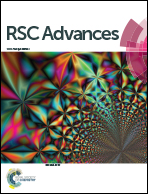Research on the deactivation mechanism of a denitration catalyst WO3–V2O5/TiO2 at a coal-fired power plant†
Abstract
The spent and fresh V2O5–WO3/TiO2 monolith catalysts were collected from a coal-fired power plant. The de-NOx efficiency dropped by 20% after the fresh catalyst was used for 30 000 h. Then, the catalysts and the fly ash attached to spent catalysts were collected and analyzed. It was found that the relative amount of Si and Al increased by 80.84% and 2.26 times, respectively, which indicated that a lot of sediments deposited on the surface of the catalyst. Moreover, the content of Na, K, Ca and Fe increased in different degrees. A few new elements, such as Cl, Zn and Pb, appeared on the surface of the deactivated catalyst, and all of these elements had bad effects on the activity. Some kinds of ammonium salts and sulfates emerged on the fly ash, which showed that the catalysts were poisoned by SO2. The special area decreased only by 4.39 m2 g−1. The V3+/(V4+ + V5+) ratio in the catalyst increased from 0.09 to 0.45 after deactivation, and V4+ decreased by about 39.54%, which caused the deactivation of the catalyst. The surface acidity of the deactivated catalyst decreased a lot, which might be the immediate cause of deactivation. The particle size of TiO2 increased due to sintering. The main causes for the deactivation may be described as active sites decreased, poisoned and covered.



 Please wait while we load your content...
Please wait while we load your content...